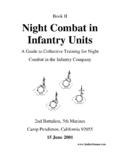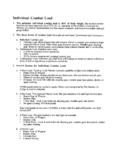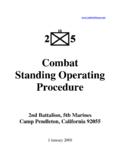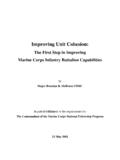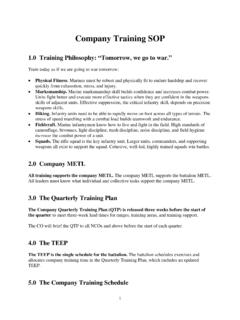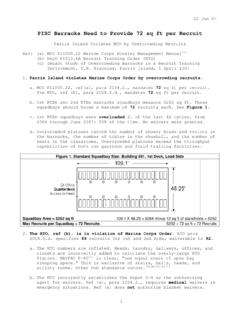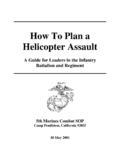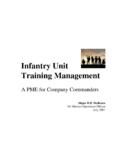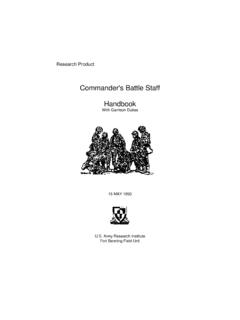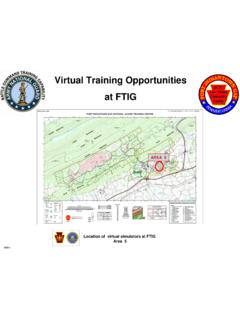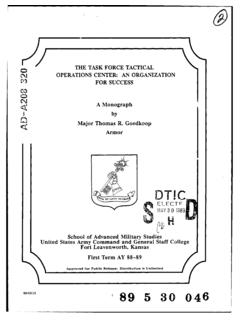Transcription of The Urban Fight: Tools for the Tank-Infantry Team
1 Charlie Co, 2nd Tank Bn Comanche tanks , RCT-1 Tank-Infantry Smartpack The Urban Fight: Tools for the Tank-Infantry team M1A1 Tank Characteristics: Engine = 1500 hp Turbine Speed = mph forward / 25 mph backwards Range at 25 mph = 273-298 miles Fuel Types=JP8, DF-2, Mogas Weight w/combat load = 68 tons 360 degree turret traverse in 8 seconds M1A1 Tank Advantages: The M1 Abrams series tanks possess lethal firepower. A platoon of these tanks has more firepower than an infantry company. The M1 has four killing systems: 120-mm main gun COAX machine gun loader's gun .50-caliber machine gun Because of it size and weight, the M1 tank can breach buildings and walls. tanks can move rapidly over a variety of terrain conditions. They have enhanced target acquisition systems, organic air defense, can provide two types of smoke for point obscuration, and, when equipped with the mine plow or mine roller, enhance mobility. tanks can transport infantry and critical supplies.
2 tanks can provide mobile cover from small arms for infantry . Because of its height, the M1 tank provides an excellent observation platform. They can breach obstacles, kill quicker and mass combat power much faster than an infantry company. M1A1 Tank Capabilities: Obstacles: Climb 3-foot high rubble, concertina, or log barricades Cross <9-foot tank ditches Climb 60% incline, 40% side slope Weapons: 1. Commander s M48 .50 cal HBMG, 1000 rounds combat load: Highly accurate, 3x Magnified sight with stadia lines to 1800m Un-stabilized, not designed for shooting on the move No night sight 1 Charlie Co, 2nd Tank Bn Comanche tanks , RCT-1 2. COAX M240 MG, 11,500 rounds combat load: Fully integrated with GPS and ballistic solution, most accurate M240 on the battlefield Full night capability via thermal sights Stabilized Truly effective to 900+ meters 3. Loader s M240: Free-gun primarily for defensive suppressive purposes For shooting bad guys off of the turret and back deck 4.
3 120 mm Main Gun, 40 rounds combat load: Laser Range Finder Thermal Imaging Night Sight Hydraulically stabilized turret/gun system Ammunition: The current selection of main gun ammo consists of 120mm HEAT, MPAT (ground mode), HE-OR-T (XM908 Obstacle Reducing Round), and SABOT. SABOT is an armor-defeating round and less useful in the MOUT environment. HEAT ammunition will open a large hole in reinforced concrete or masonry structures, far larger than MPAT or MPAT-OR (XM908). Both MPAT and MPAT-OR offer great penetration. HEAT ammunition arms at approximately 60 feet from the gun muzzle. It loses most of its effectiveness against Urban targets at ranges of less than 60 feet. MPAT and MPAT-OR rounds arm approximately 100 feet from the muzzle end of the gun. Because of the shape and metal components of the projectiles, however, this ammunition remains effective at ranges of less than 100 feet. Sabot petals, including those on MPAT and MPAT-OR, endanger accompanying dismounted infantry .
4 They create a hazard area extending 70 meters on either side of the gun-target line out to a range of 1 kilometer. Communications: tanks are equipped with two single channel ground/airborne radio systems (SINCGARS). Tank-Infantry phones are attached to the right rear of the tank. They provide instant communication between the infantryman on the ground and the tank commander. FAC/FO modifications on the HQs tanks provides additional communication assets in order to reach artillery and air support. Each tank is equipped with a GPS with an external antenna modification in order to provide quick and accurate position reports while closed hatched. M1A1 Tank-Infantry Modifications: Heat Deflectors: The tank's 900-degree exhaust will burn the skin if the exhaust grate or deflector shield is touched. Heat shields may be constructed from sheet metal and bolted to the exhaust grates to deflect the tank s heat and exhaust downward, enabling infantry to walk behind the tank. The shield may be mounted to deflect the exhaust upward.
5 However, the exhaust will then interfere with the thermal sight when engaging to the rear. Tankers must warn infantry of 2 Charlie Co, 2nd Tank Bn Comanche tanks , RCT-1 the extreme exhaust temperature. infantry must keep in constant communications with the tank crew in case the tank needs to move. Other Assets: M88A2 Recovery Vehicle is an armored platform to conduct quick retrieval of any immobile tank. In addition, the recovery vehicle can act as an improvised ambulance in order to remove battlefield casualties to a more secure location for medevac. M1A1 Tank Disadvantages: Vulnerable to attack in restrictive terrain. Cannot traverse certain types of terrain. Emit a significant audio and visual signature on the battlefield. Require a greater amount of logistical and maintenance support. Have limited air defense capability. M1A1 Tank Limitations: Dead Space: The tank s main gun and coax machine gun can depress to -10 degrees and elevate to +20 degrees.
6 This creates considerable dead space for tank crews at close ranges, which are typical during Urban operations. Engaging targets at rooftop level requires the crew to be at least 30 meters away to be able to elevate to rooftop level. For a target located on the 6th or 7th floor, crews must be a minimum of 60 meters away from the target. Crews may back up or use rubble, vehicles, or higher elevation to allow them to elevate and engage targets. When supporting infantry , TCs should seek these positions to support with fire. With an average street width of 16 meters in Urban areas, traversing the main gun may be difficult. Crews must consider the rear of the turret as well as the muzzle end of the gun. Crews should allow 6 feet of clearance for the back of the turret. They must account for additional length if additional gear or equipment has been stowed on the stowage racks. 3 Charlie Co, 2nd Tank Bn Comanche tanks , RCT-1 Closed Hatches: Conducting operations with closed hatches creates considerable dead space where the enemy may approach and emplace explosives.
7 Most streets are less than 16 meters wide in Urban areas. This short width creates dead space where the crew cannot observe through their vision blocks or engage with crew-served weapons. Using tank sections and infantry support can greatly mitigate this risk by maintaining constant observation of these areas. Tank crews must not become overdependent on infantry support to cover this dead space. Brief infantrymen that if they take cover in this area, they may be killed when the tank turns, pivots, or backs up. 4 Charlie Co, 2nd Tank Bn Comanche tanks , RCT-1 Main Gun Overpressure: Dismounted Marines may be injured or killed from the overpressure and discarding sabot pedals from the 120mm cannon, falling glass, and debris created by the overpressure and rounds impacting on buildings. Fire Control Limitations in Urban Environment: The fire control system cannot provide a ballistic solution for less than 200 meters for the main gun. A battle sight range of 300 meters for the main gun will enable crews to engage targets at 0 to 600 meters and provide faster engagement times.
8 Fratricide Avoidance: Due to the rapid movement of friendly infantry seeking covered and concealed positions, the chance of fratricide greatly increases. Communications between tank crews and infantry is critical to prevent fratricide. Man-portable radio systems must be used to keep constant contact between the tank and infantry . Recognition markings must be established. Tank crews should use the GPS in both daylight and TIS channel to observe infantry in all their gear prior to operations. TCs, loaders, and drivers should use passive systems to observe infantry . Logistics Burden: To keep attached tanks mission-capable requires planning for refueling and rearming. Additionally, there may be a requirement for recovery of one or more tanks because of maintenance problems or the tank being disabled during contact. infantry logisticians need to ensure they understand the planning factors for fuel and ammunition consumption, and then make the necessary arrangements for adequate resupply, maintenance support, and recovery capability.
9 Failure to do so can result in unnecessary loss of attached tanks . Push the necessary support packages well forward on the battlefield. Put them under the control of the company tank leader to provide the most immediate support reaction. This will shorten the recovery period. Techniques for Employment: 1. Use of tanks in a support by fire for the infantry . Employ tanks as a support-by-fire element. Employ stand-off to maximize the effectiveness of the tank s weapon systems. Stand-off allows for greater coverage of the objective. Use clearly understood control measures graphic, visual and direct and indirect fire to mark the progress of the infantry . Maintain enough maneuver flexibility that tanks can reposition their support-by-fire positions based on, and relative to, the infantry advance. All the tanks in the combined arms force should not be dedicated to support by fire. 5 Charlie Co, 2nd Tank Bn Comanche tanks , RCT-1 2. Use tanks to maneuver infantry squads into the village.
10 With some tanks in the support-by-fire role, the remaining tanks can move infantry into a position to gain the foothold. tanks typically train, operate, and fight as platoons. In the Urban fight, the Marine Corps comfortably operates down to the section level. Never separate a tank section. Crews train as sections. This facilitates target acquisition, hasty recovery (without an M88, only a tank can recover a tank), and allows for ammunition transfers internally (between ready and semi-ready ammo racks) and externally (cross-decking). Like an infantry fireteam, the section is the lowest operating echelon for tanks . tanks can provide a mobile shield for dismounted infantry , protecting them from small-arms fire and shell fragments. This allows an infantry squad to move behind a tank forward to the targeted building. The tank also provides immediate direct fire support for any threat to the infantry squad. tanks can move a maximum of nine personnel. After gaining the foothold, continue to use tanks to move infantry .
